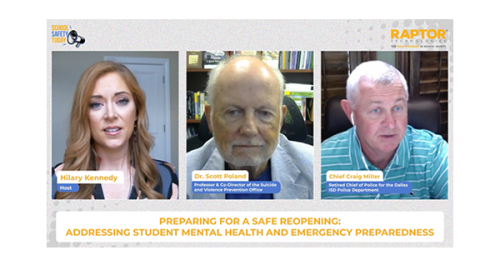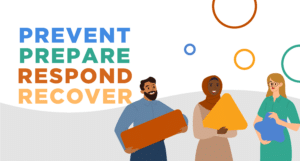Being isolated from their friends and families, as well being exposed to trauma, has negatively affected many students’ wellbeing. This consequence of the pandemic is why experts are motivating schools to focus on mental health needs and be ready for a possible increase in school violence.
Dr. Scott Poland, Professor and Co-Director of the Suicide and Violence Prevention Office, and Chief Craig Miller, Retired Chief of Police for the Dallas ISD Police Department, recently shared insights into how schools can address these critical concerns.
A summary of their conversation is below. Listen to the full episode of our podcast, Preparing for a Safe Reopening: Addressing Student Mental Health and Emergency Preparedness.
Addressing Student Mental Health
Mental health—the general state of our wellbeing—affects many areas of our lives, including how we react to and manage stressors, our energy levels, and our relationships with our peers. Students need mental health services more than ever before, according to Dr. Poland, because of the trauma they have experienced throughout the pandemic.
Responding to this mental health crisis requires everyone’s involvement. “I believe in a partnership between schools, law enforcement, and mental health personnel,” says Dr. Poland. “To really safeguard our children, we need everybody involved, and very importantly, their parents.”
Schools also need to acknowledge how the pandemic disproportionately affected students of color and those from homelessness or poverty. Not only can they experience more mental health issues due to the increased trauma they experienced compared to their wealthier peers, but these students also “fell further behind because of the lack of technology or not having parents that were home that could help during virtual learning.”
Vetting Violent School Threats
As we prepare for the 2021-2022 school year, there is still the same fear as before: an active shooter or violent event on campus. When asked what keeps him up at night, Chief Miller shared it’s the threats because it’s these threats that lead to the potential of an active shooter.
His recommendation to schools is to respond to and thoroughly vet every threat. There is this belief that only large schools receive threats, but Chief Miller, having worked in schools of all sizes, says that is incorrect. All schools, regardless of size or location, need to be ready to respond to threats and emergencies.
“We all have to work on prevention in our homes, our schools, and our communities,” Dr. Poland says about being prepared for active shooters. Law enforcement should be involved in planning school safety procedures and policies. The more involved they are in creating and practicing the school’s emergency plans, the better they can respond in an actual emergency. “If the district is committed to safety and takes the time to interact with law enforcement, it will certainly benefit them long term,” Chief Miller states.
Preventing Student Suicide and the Role of SROs
Prior to the pandemic, suicide was the second leading cause of death in children over 10 years old. According to Dr. Poland, death of loved ones, being in isolation, and experiencing poverty may lead to more student suicides. “We’re seeing increasing numbers of children even under the age of 10 threatening suicide now. [These threats] must be taken seriously every single time.”
Dr. Poland further advises schools to complete comprehensive suicide prevention training annually. Everyone—staff, teachers, bus drivers, and janitors, to name a few—should attend the trainings to learn suicide warning signs and how to respond.
Dr. Poland says every student needs a go-to person at their school that they feel comfortable talking to. Law enforcement and School Resource Officers (SROs) can be that person. “Our job is not merely to make arrests,” Chief Miller shares, “But it is to develop relationships with the students.” As SROs build trust and relationships with students, they can see when a student is suffering and recognize the warning signs. “Because they have that relationship [with the student]” Chief Miller continues, “the officers can communicate these concerns with the school’s mental health team.” This helps ensure that the students receive the help they need.
Preparing for, Responding to, and Recovering from Emergencies
It’s imperative that schools—and everyone inside of them—know exactly what to do in an emergency. Creating an Emergency Operations Plan (EOP) in collaboration with law enforcement and other stakeholders is critical. Your EOP should cover the entire timeline of incidents, clearly describing what actions each person—students, staff, and external resources like first responders and public or mental health professionals—will take before, during, and after incidents. Your plan should have policies around how to manage localized incidents, how to alert first responders of emergencies, how to account for students and reunify them with approved guardians, as well as how to adjust school policies during a pandemic—just to name a few. The EOP should also detail the training curriculum and schedule that staff and students must follow.
After an incident, Dr. Poland says schools and law enforcement must debrief to discuss what worked and what could have been done better. His advice is also to:
- Reach out to families that lost a loved one and to anyone that was injured
- Quickly schedule a parent meeting to give parents information on suicide warning signs and how to help their children recover from the emergency
- Take assistance from those who offer, including applying to Project SERV, which provides funding to schools in the aftermath of a school shooting
- Name a recovery coordinator who will be responsible for helping the district move forward
“Threat assessment, less gun access, better mental health services, taking threats seriously, and of course having everyone involved… this can all help with response,” Dr. Poland concludes.
Evolving as the School Safety Landscape Changes
When it comes to school safety and emergency management, there are always new considerations around safety, changes to statutes and regulations, and professional as well as cultural shifts to account for. Subscribe to our podcast, School Safety Today, on Apple Podcast or Spotify to learn more advice and best practices from some of our industry’s greatest experts.





